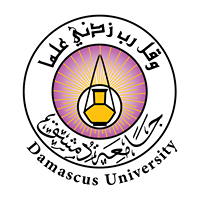The aim of this study was to estimate the total amount of phenolic compounds of olive
trees leaves (Olea europaea L.) as Biomarker for the assessment of lead air pollution at
Banias area. Olive trees were selected as the predominant species in the
study area. The
samples were collected from 6 locations at different distances from the vicinity of the
Banias refinery (0.1, 0.5, 2, 4, 6, 10) Km. The dominated wind in the region is western -
southwesterly during the winter (March) and summer (September), The control was taken
from an area about 20 km from the refinery to the north-east (al-Qardahah rural).
The concentration of total phenolic compounds (TPC) during the summer was (45.6-70.85)
mg GAE/g dw and in the control (40.4) mg GAE/g dw, and during the winter the content
of TPC was (35.6-52.9) mg GAE/g dw and in the control (25.8) mg GAE/g dw. The
concentration of Lead (Pb) in unwashed leaves during the summer was (0.879 – 2.170)
ppm and in the control (0.005) ppm, whilst during the winter was (0.479-1.023) ppm and
in the control (0.00083) ppm. The results showed significant differences in the
concentration of total phenolic compounds and lead between sites (Anova test). High
concentration of total phenols and lead in the summer compared to values in winter at all
sites (t-test). The results also showed a negative correlation between the concentration of
total phenolic compounds and lead with the distance from the refinery of Banias. Finally,
The results showed that the TPC can be used as biomarker of lead air pollution in Banias
area.
This study was designed to estimate the allelophatic effect of cogongrass (Imperata
cylindrica L.), in the growth of one year old of olive seedlings, in a nursery (greenhouse)
conditions. Two experiments were conducted in this study. In the first e
xperiment, the
effect of the aqueous extracts of cognograss leaves, rhizomes, and roots, at concentrations
of (2%, 4% and 8%) on the growth of olive seedlings (total length and diameter) were
evaluated. The results of this experiment indicated an inhibitory effect of the 4% and 8%
aqueous extracts on growth parameters. It was found that treatments with 4% and 8%
aqueous extracts caused significant reduction (60.2% and 83%) respectively in the total
length, in compare to the control. As for the 2% aqueous extract, it showed a stimulation
effect in the growth, an increase about 31.5% was recorded for the total length in compare
to the control. A similar result was observed in regard the seedlings diameter growth. The
2% aqueous extract showed an 56.8% increase in the rate of diameter growth, while the
4% and 8% extracts showed a reduction effects 80% and 91.5% respectively. The second
experiment evaluated the effect of dried powder of cogongrass parts at concentrations of
(2%, 4% and 8%) on the growth of olive seedlings.
The aim of this research is to optimize the selection of the sites of Evaporation
Tanks/Ponds, of Olive Mill Waste Water (OMWW). We have to achieve strict
environmental conditions, which in turn relate to a wide range of factors including
topograp
hy, namely: elevations, rivers, silos, lakes and faults, in addition of those related
to man-made geographical elements: cities, villages, roads, dams, wells and contemporary.
To complete the study and obtain reliable results, we adopt GIS, which requires defining
all of the above factors in the form of a graphical and descriptive environment.
The choice of potential sites is through verification of the required conditions using GIS.
This requires the availability of data specific to each condition, verification of other
conditions through field visits and measurements in the absence of necessary data, and it is
necessary to use the available space images significantly through GOOGLE EARTH for
initial verification of selected sites.
Appropriate technology is used according to the state of the OMWW, and according to the
economic potential of the application of this technology. The main objective of these
treatments is to reduce their load of organic matter. The remaining water will be used to
irrigate the agricultural land. Production of manure and feed of cattle.
Total Polyphenol was studied in olive leaves collected from Lattakia area
(AlQurdaha zone), where Phenolic compounds were extracted from dry Olive leaves by
using two extraction methods: maceration and Ultrasonic Device. By the both two methods
a
study was carried out on the extraction solvent concentration effect where the extraction
was done by using the mixture of Ethanol-Water with different percentages (60,70,80
%). As well, The extraction temperature effect was studied at the both methods at (20,30,
40°C); in addition to the study of the extraction time effect.
At the method of Maceration Extraction, the total polyphenols amount was studied in
dry olive leaves after extraction during different times (24,48,72 h). While at the Ultrasonic
Extraction the times were (10,20,30 min).
The study showed that the highest amount of phenolic compounds were existed in
dry olive leaves which were extracted by Ultrasonic Waves with the concentration of the
solvent ethanol-water 80%, temperature of 40°C, and with an extraction time of 20min.
Ash toxicity of burning pruning residues of three plant species i.e. apple, grape and
olive was tested against adults of cowpea seed beetle Callosobruchus maculatus
(F.) (Coleoptera, Bruchidae) using the following concentrations: (5, 10, 20, 40
an
d 80) g/kg of cowpea seed. The study was carried out in incubator at fixed
temperature and humidity at Biotechnology Research Center, Al-baath University.
Readings were taken after (24, 48 and 72) h of treatment, and corrected mortality
rates were calculated and values of LC50, LC90, LT50 and LT90.
The Bio-mass was isolated from the medium of the water olive
soaking , and was developed on two medium olive mill wastewater
OMW.
To determine the susceptibility of some olive varieties to the
disease of eye peacock, We studied the development of eye peacock
disease on 3 varieties (Khadairy - Zorzalina - Frontoio. The
percentage of infected leaves and the severity of infection were
estimated during spring and autumn months, the maximum period
of the spread of the disease.
The following research
aims to characterize the work of olive mills in the study area with an
attempt to offer some of the competitive advantages offered by these
mills. Most of the studied mills are modern mills and have an
individual investment
of an average age of 12 years, Which means
that this sector is managed by a group of persons with high expertise
may contribute to raising the performance of the work in the mill.
This study was conducted during the period 2014-2016 in the nursery College of
Agriculture, University of Tishreen, this study aimed to calculate the percentage of
germination of the seeds of Laurus nobilis and Pinus pinea using different proportio
ns of
olive cake with a mixture Arboretum, and study some of the planter resulting properties as
well as some physical and chemical characteristics of agricultural mixture that used. were
analyzed using spss statistical program
The mixing nursery soil (sand, soil 1: 1) with olive cake rates (25,50,75,100)% .
assessment: germination percentage, wet and dry weight of shoot and root grouped,
volumetric weight, moisture middle and chemical characteristics. , For germination
percentage it has increased every germination of seeds of laurel and pine fruiting increase
the proportion of bagasse in the agricultural center in general ratio, and on the contrary has
increased wet weight of shoots with decreasing proportion of olive cake in both types
studied. For the physical properties there was a decrease in the volumetric weight of the
agricultural community to increase the proportion of the studied olive cake, as soil
moisture ratio increased to increase the proportion of bagasse. Rich agricultural circles
used container Regarding chemical properties have been observed on the olive cake metal
elements (iron, magnesium and copper), The salinity and acidity remained within normal
limits, so the study has demonstrated the validity of the use of olive cake as a medium for
planting in whole or in part agricultural mixtures used in nurseries.
We discussed the importance of studying the trichomes award in
olive trees, leaves and its role in the resistance to these trees against
pollution resulting from the Banias refinery intake, through the
study of their density and distribution on a
superficial paper and
examine the concentration of chlorophyll in the leaves, and
comparing the results between the contaminated areas and the
control area .
Results showed that the density of the trichomes play a role in
protecting the ports of entry into force of pollutants into the plant
tissue, and its impact on the pigments of photosynthesis, and thus
the process of photosynthesis.


